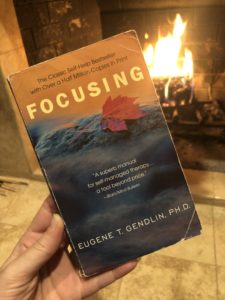
Focusing
Recently, we talked about the 7+/-2 principle of working memory and how the brain is a pinball machine. We went on to talk about how therapy work like journaling and PCT can be effective, and how to maximize the 7 +/-2 principle in our work with clients. Which is great! And now, I want to see about taking things to a whole new dimension…
You can only THINK ABOUT 7+/-2 things at a time. Even when we’re maximizing that, clients can only experience a few of the multiple parts (e.g., thoughts, feelings, sensations) of any given situation in sequence. But you can SENSE the whole thing at once, if you allow yourself to do that and don’t rush to get ahead of yourself with words. This is called the felt sense. The felt sense (Gendlin, 1978) is different from feelings, emotions, thoughts, or regular body sensations. It is the fuzzy, unclear “gestalt” of awareness.
The felt edge is the next step that follows completely naturally from the complete felt sense and leads in the direction of more life in the body. Every natural experience has a natural next step, and only that next step will REALLY satisfy.
Hunger → eating; Arousal → orgasm; Grief → tears; Curiosity → exploration
What options do you have when you are thirsty?
Exercise? Reading a book? Vodka? Pineapple? Water? Gatorade? (Infinite options!) But which one is the one to which your thirst is leading? The BODY KNOWS.
The felt edge is like standing in patient readiness, without tension, observing all of the possible next steps and getting the sense of what feels like more life in the body.
Focusing is the process by which we can experience the felt sense of any given problem or situation – the whole of it, at once – and thus, approach the felt edge where we are most likely to have an awareness of the most right next movement.
The Six Steps of Focusing
- Clearing a Space – Asking yourself: What is the main thing for me right now? Sense it, but don’t go inside
- Felt Sense – Experience (“Feel”) the many parts of whatever it is, all together. Get a sense of what all of the problem feels like.
- Handle – Give a name, phrase, or image to the quality of the whole felt sense.
- Resonating – Gently go back and forth between the felt sense and the handle, patiently ensuring that you have just the right fit.
- Asking – “What makes the problem so _____?” “What is ___ in this?” Be sure you are sensing freshly (not remembering!) the felt sense. If you get a quick answer, without feeling it in the body, let that go and stay with it.
- Receiving – Be open, in a friendly way, to any shift in the body. This will be accompanied by some change in the whole of the problem. Accept that change gently.
If you want to learn more about this, you’ve absolutely got to read Focusing (Gendlin, 1978). It’ll change your life, your therapy, and your clients’ lives… guaranteed. And if you think you can’t learn something so experiential from a book…try it anyway. Focusing is all about tuning in to your own experience anyway; Gendlin’s voice through his writing may be all you need for direction.
Tons of other free resources and readings of Gendlin’s and The Focusing Institute here.
Gendlin, E.T. (1978). Focusing (first edition). Everest House.
Comment below if you use Focusing in session, or if this is your first exposure!